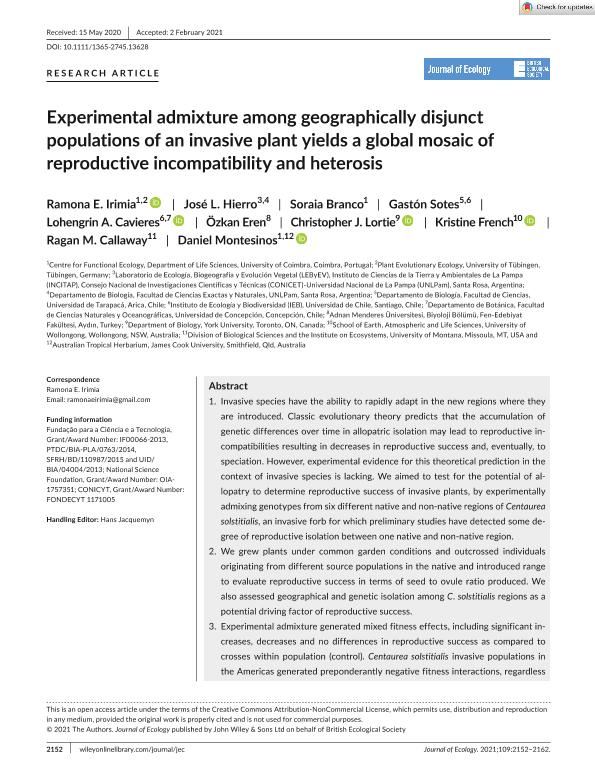Mostrar el registro sencillo del ítem
dc.contributor.author
Irimia, Ramona E.
dc.contributor.author
Hierro, Jose Luis

dc.contributor.author
Branco, Soraia
dc.contributor.author
Sotes, Gastón Javier

dc.contributor.author
Cavieres, Lohengrin A.
dc.contributor.author
Eren, Ozkan

dc.contributor.author
Lortie, Christopher J.
dc.contributor.author
French, Kristine
dc.contributor.author
Callaway, Ragan M.
dc.contributor.author
Montesinos, Daniel
dc.date.available
2023-01-05T11:20:34Z
dc.date.issued
2021-02
dc.identifier.citation
Irimia, Ramona E.; Hierro, Jose Luis; Branco, Soraia; Sotes, Gastón Javier; Cavieres, Lohengrin A.; et al.; Experimental admixture among geographically disjunct populations of an invasive plant yields a global mosaic of reproductive incompatibility and heterosis; Wiley Blackwell Publishing, Inc; Journal of Ecology; 109; 5; 2-2021; 2152-2162
dc.identifier.issn
0022-0477
dc.identifier.uri
http://hdl.handle.net/11336/183449
dc.description.abstract
Invasive species have the ability to rapidly adapt in the new regions where they are introduced. Classic evolutionary theory predicts that the accumulation of genetic differences over time in allopatric isolation may lead to reproductive incompatibilities resulting in decreases in reproductive success and, eventually, to speciation. However, experimental evidence for this theoretical prediction in the context of invasive species is lacking. We aimed to test for the potential of allopatry to determine reproductive success of invasive plants, by experimentally admixing genotypes from six different native and non-native regions of Centaurea solstitialis, an invasive forb for which preliminary studies have detected some degree of reproductive isolation between one native and non-native region. We grew plants under common garden conditions and outcrossed individuals originating from different source populations in the native and introduced range to evaluate reproductive success in terms of seed to ovule ratio produced. We also assessed geographical and genetic isolation among C. solstitialis regions as a potential driving factor of reproductive success. Experimental admixture generated mixed fitness effects, including significant increases, decreases and no differences in reproductive success as compared to crosses within population (control). Centaurea solstitialis invasive populations in the Americas generated preponderantly negative fitness interactions, regardless of the pollen source, suggesting selection against immigrants and reinforcement. Other non-native populations (Australia) as well as individuals from the native range of Spain demonstrated an increase in fitness for between-region crosses, indicating inbreeding. These differences show an asymmetrical response to inter-regional gene flow, but no evidence of isolation by distance. Synthesis. The speed of adaptation and the accumulation of reproductive incompatibilities among allopatric populations of invasive species might be more rapid than previously assumed. Our data show a global mosaic of reproductive outputs, showcasing an array of evolutionary processes unfolding during colonization at large biogeographical scales.
dc.format
application/pdf
dc.language.iso
eng
dc.publisher
Wiley Blackwell Publishing, Inc

dc.rights
info:eu-repo/semantics/openAccess
dc.rights.uri
https://creativecommons.org/licenses/by-nc/2.5/ar/
dc.subject
ALLOPATRY
dc.subject
BIOLOGICAL INVASIONS
dc.subject
FECUNDITY
dc.subject
GENE FLOW
dc.subject
LOCAL ADAPTATION
dc.subject
REPRODUCTIVE ISOLATION
dc.subject
YELLOW STARTHISTLE
dc.subject.classification
Ecología

dc.subject.classification
Ciencias Biológicas

dc.subject.classification
CIENCIAS NATURALES Y EXACTAS

dc.title
Experimental admixture among geographically disjunct populations of an invasive plant yields a global mosaic of reproductive incompatibility and heterosis
dc.type
info:eu-repo/semantics/article
dc.type
info:ar-repo/semantics/artículo
dc.type
info:eu-repo/semantics/publishedVersion
dc.date.updated
2022-09-30T17:56:30Z
dc.journal.volume
109
dc.journal.number
5
dc.journal.pagination
2152-2162
dc.journal.pais
Reino Unido

dc.journal.ciudad
Londres
dc.description.fil
Fil: Irimia, Ramona E.. Eberhard Karls Universität Tübingen; Alemania. Universidad de Coimbra; Portugal
dc.description.fil
Fil: Hierro, Jose Luis. Consejo Nacional de Investigaciones Científicas y Técnicas. Instituto de Ciencias de la Tierra y Ambientales de La Pampa. Universidad Nacional de La Pampa. Facultad de Ciencias Exactas y Naturales. Instituto de Ciencias de la Tierra y Ambientales de La Pampa; Argentina
dc.description.fil
Fil: Branco, Soraia. Universidad de Coimbra; Portugal
dc.description.fil
Fil: Sotes, Gastón Javier. Consejo Nacional de Investigaciones Científicas y Técnicas. Instituto de Ciencias de la Tierra y Ambientales de La Pampa. Universidad Nacional de La Pampa. Facultad de Ciencias Exactas y Naturales. Instituto de Ciencias de la Tierra y Ambientales de La Pampa; Argentina. Universidad de Chile; Chile
dc.description.fil
Fil: Cavieres, Lohengrin A.. Universidad de Chile; Chile. Universidad de Concepción; Chile
dc.description.fil
Fil: Eren, Ozkan. Adnan Menderes Universitesi; Turquía
dc.description.fil
Fil: Lortie, Christopher J.. University of York; Reino Unido
dc.description.fil
Fil: French, Kristine. No especifíca;
dc.description.fil
Fil: Callaway, Ragan M.. University of Montana; Estados Unidos
dc.description.fil
Fil: Montesinos, Daniel. Universidad de Coimbra; Portugal
dc.journal.title
Journal of Ecology

dc.relation.alternativeid
info:eu-repo/semantics/altIdentifier/doi/http://dx.doi.org/10.1111/1365-2745.13628
Archivos asociados
